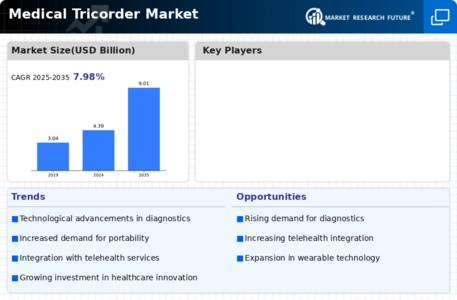Market Growth Projections
The Global Medical Tricorder Market Industry is projected to witness substantial growth in the coming years. The market is expected to reach 4.39 USD Billion in 2024, with a remarkable increase anticipated to 9.01 USD Billion by 2035. This growth trajectory indicates a compound annual growth rate of 6.76% from 2025 to 2035. Such projections reflect the increasing adoption of medical tricorders across various healthcare settings, driven by technological advancements and rising consumer demand. The market's expansion is indicative of a broader trend towards innovative healthcare solutions that prioritize efficiency and accessibility.
Technological Advancements
The Global Medical Tricorder Market Industry is experiencing rapid growth due to ongoing technological advancements in diagnostic tools. Innovations in sensor technology, data analytics, and artificial intelligence are enhancing the capabilities of medical tricorders. These devices are increasingly able to perform complex analyses and provide real-time health monitoring. For instance, the integration of machine learning algorithms allows for more accurate disease detection and patient assessment. As a result, the market is projected to reach 4.39 USD Billion in 2024, with a robust growth trajectory leading to an estimated 9.01 USD Billion by 2035.
Government Initiatives and Funding
The Global Medical Tricorder Market Industry benefits from various government initiatives aimed at promoting healthcare innovation. Many governments are investing in research and development to enhance medical technologies, including tricorders. Funding programs and grants are being allocated to support startups and established companies working on advanced diagnostic solutions. These initiatives not only foster innovation but also aim to improve healthcare outcomes on a global scale. As governments recognize the potential of medical tricorders in transforming healthcare delivery, the market is likely to see increased investment and support, driving further growth.
Rising Demand for Remote Monitoring
The Global Medical Tricorder Market Industry is significantly driven by the rising demand for remote patient monitoring solutions. As healthcare systems evolve, there is a growing emphasis on telemedicine and home healthcare services. Medical tricorders facilitate remote diagnostics, enabling healthcare providers to monitor patients' health conditions from afar. This trend is particularly relevant in rural and underserved areas where access to healthcare is limited. The convenience and efficiency of these devices are likely to contribute to a compound annual growth rate of 6.76% from 2025 to 2035, reflecting a shift towards more accessible healthcare solutions.
Increasing Prevalence of Chronic Diseases
The Global Medical Tricorder Market Industry is influenced by the increasing prevalence of chronic diseases such as diabetes, cardiovascular disorders, and respiratory illnesses. These conditions necessitate continuous monitoring and timely interventions, which medical tricorders can provide. The ability to track vital signs and health metrics in real-time allows for proactive management of chronic diseases, potentially reducing hospital visits and healthcare costs. As the global population ages and the incidence of these diseases rises, the demand for efficient diagnostic tools like medical tricorders is expected to grow, further propelling market expansion.
Consumer Awareness and Health Consciousness
The Global Medical Tricorder Market Industry is also shaped by rising consumer awareness and health consciousness. Individuals are becoming more proactive about their health, seeking tools that enable them to monitor their well-being effectively. Medical tricorders, with their user-friendly interfaces and comprehensive health assessments, appeal to this growing demographic. As consumers demand more personalized healthcare solutions, the market is poised for expansion. The increasing interest in preventive healthcare and self-monitoring is likely to contribute to the overall growth of the industry, aligning with the projected market figures.




Leave a Comment